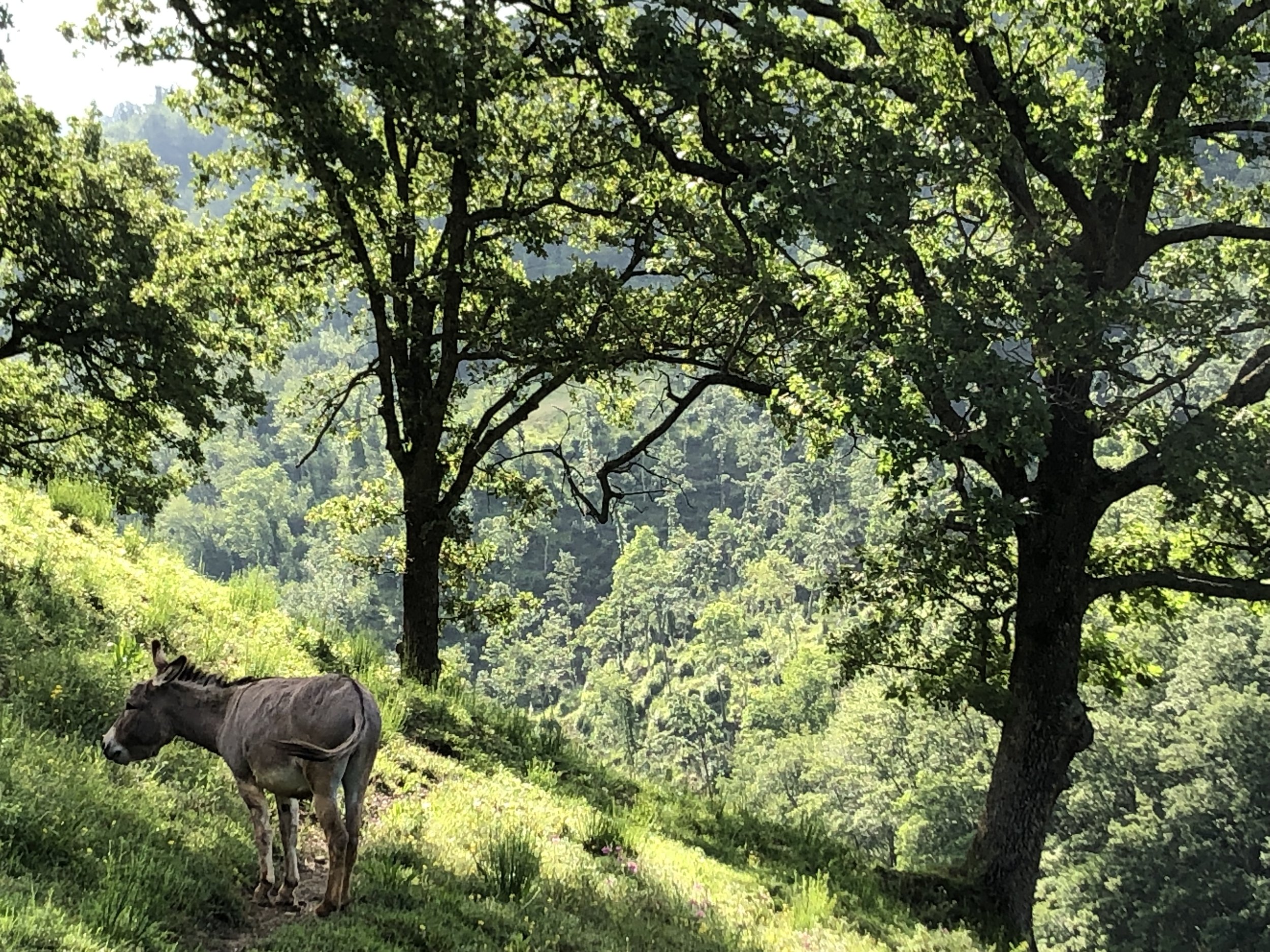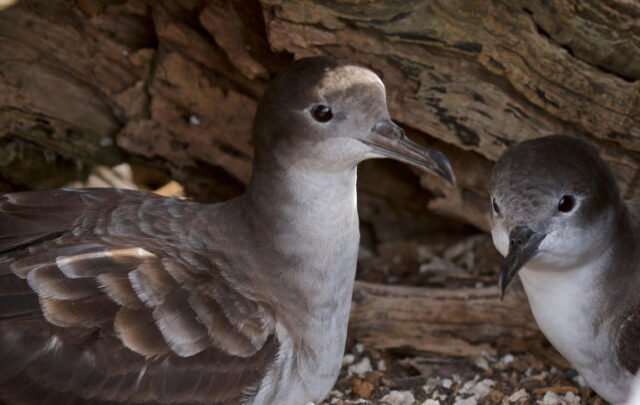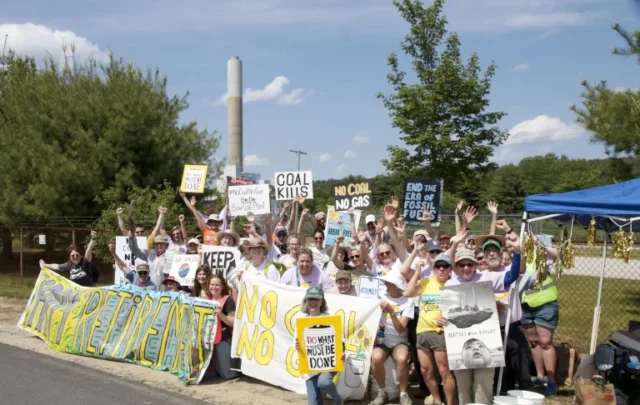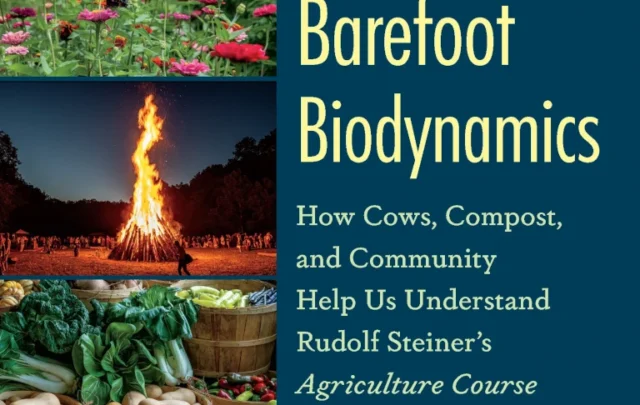Since nature has the most sustainable ecosystem and since ultimately agriculture comes out of nature, our standard for a sustainable world should be nature’s own ecosystem… Wes Jackson
I grew up in Chicago. I had never seen a real farm. My favorite book was Charlotte’s Web. My idealized child’s imagination saw a farm as growing everything we need—our bread and fruit, vegetables and cheese. The animals gathered in the barnyard—one of each—solving one another’s problems. A farm was a happy place, a place of wisdom, fun, and growth. I am not in agreement with Jared Diamond, that agriculture was the worst mistake our species has made. But the way most of us pursue it now has become a large part of converging crises. We urgently need to ask ourselves how this came about. What was a farm? What could it be? What does it have to be to grow our food in a very uncertain future?
Farming has become a euphemism, a delicate term for something offensive or unpleasant… industrial agriculture. I have seen farmers chop up the living earth, level it out so that nothing is left alive above or below the surface of the soil, inject seeds, spray a vast variety of man-made chemicals, and harvest all from high up on mammoth machines. They break the land to fit a limited number of lucrative crops. I am guessing that these men on tractors never pick up the soil with their bare hands to feel it, smell it, taste it. A monoculture is static with no diversity and that is part of the problem. A monoculture dies if it is not constantly supported. Any connection to the natural world, to the physical earth, has been severed.
What is the alternative?
Without the tractor and harvesting machines, without the monoculture, by allowing trees and hedgerows and animals to return to the land, by encouraging small farms which feed the local community, we can build back our ecosystems and create a more resilient food supply at the same time. The small sustainable farm will blur the edges between the surrounding land and crops. It is the polar opposite of industrial agriculture. When it remains a part of the natural world, the farm becomes a place of alchemy, of wellness. And, when it is free of off-farm inputs, it can generate more money and involve far less energy expenditure—human as well as fossil fuel. Farming within the natural world could revitalize our local communities as well. Can we plant nut and fruit trees and hedge rows of berry brambles everywhere? Can we feed the world this way? To be honest, I don’t know. But we could try. What if, just what if, every backyard in the city and suburb, every vacant lot and park and rooftop were farmed as a community of plants and animals, as an ecosystem?
Before I had a farm, I had a rambling cottage garden. It informed what I do now. When I first began to cultivate plants—in a city front yard—I had only wanted to come home from work and open the gate to a small bit of enchantment and tranquillity. A friend suggested native plants suited to the local soil and climate. They maintained themselves—and multiplied—without much attention from me. I bought vegetable and herb seedlings at a plant nursery – just a few local favorites. That first garden gave me a little food to feed my family. But that had not been my intention. I had just wanted to feed my soul.

Nature abhors a vacuum.
That was the start, a garden of plants long adapted to my region and the vegetables suited to my immediate area. But the magic began when the wild plants (called weeds by the uninformed) moved in uninvited. Some were indigenous like Joe-Pye weed and jewelweed. Some had been naturalized centuries ago: purslane and chickweed, burdock and dandelion. Some, like calendula, simply had hitched a ride with the nursery-bought plants. They found their way into the growing community (and were welcome as food and medicine). The plant diversity gave a natural beauty to the garden and actually seemed to increase the resiliency of the already established plants. I had heard—and still hear—that the weeds would suck up all the surface water, starving the intentional plants. But the wild plants, by covering every bit of the exposed earth in my first garden, helped hold moisture in the soil. Only years later did I understand that they contributed to the nutrient exchange with the established plants. Invasive wild plants are opportunistic, moving into unoccupied disturbed soil. By using cover crops and by not tilling the soil, these “weeds” are not a problem. In fact, I want those plants. They tell me everything I need to know about the health of my soil. (In a search, look for ‘weeds as soil indicators’ to learn more.) How can the gardening columns in the newspaper, the seed catalogs, the plant nurseries know anything about the particular land on which I live. And they factor in nothing about the resiliency we need with climate upheaval.

Mother Nature is not interested in monocultures. She is not interested in amber fields of grain. She cultivates in ecosystems. Rather than bend the land to fit the crops and then go through the work and expense to support them through to harvest, it seems logical to fit the crops to the land and build from there. In the natural world, most plants live in cooperative communities of canopy and understory plants in complex partnerships with the soil biota and the local animals. This is true of a forest, a swamp, a savannah, an abandoned field or a vacant lot. The composition varies from dry sites to wet sites but is also dependent on slope, the existing soil minerals, and exposure. In the forest, the canopy is the upper level of mature trees and vines but in a pasture it is the tall, dominant field grasses. Below the canopy of the tallest trees or plants is the understory: a complex mix of woody and herbaceous plants and ground covers of all types living together and, under them, in the soil, rhizomes and bulbs, roots and fungal hyphae, and distributed throughout these layers, the decomposing and the decomposers. They may be growing together because they are trading one another for the necessary resources or because they are utilizing the same environmental conditions. These are self-sustaining systems. No one is irrigating the forest, pruning and fertilizing the trees, or seeding the understory. And yet, as I look out at the forest surrounding our community, it looks greener and more robust (on a 38° C July day) than most of the surrounding farms.
Farm like an ecosystem
It is simpler and less work to grow food within a thriving local ecosystem. It involves buying little or no machinery. But there is a caveat. Because every ecosystem is defined by a specific physical environment, the organisms living within, and the climate, everyone with a garden, a small self-sufficient farm or many hectares of crops has unique conditions. There is no one way of planting, no one list of plants and animals for all of us, even if we live in the same area. There is only a general model for us to use…we must fill in the blanks. Though I have borrowed ideas from everywhere— biodynamics, permaculture, regenerative agriculture, wild farming—my best teachers have been my neighbors; people who have lived on the land, know the animals, the plants, the weather. And, in a few cases, some serve as an example of what not to do. But those who listen to the wind and watch the sky rather than the weather report—those who pay attention to the behavior of the local animals and plants—they know exactly how the climate is changing… and how rapidly. Beyond that—and perhaps the most important work—farming requires being observant… observant of what’s already on the land, learning what was there before, what plants are arriving, which ones are struggling, how the surrounding ecology is changing. Because with or without climate change, the local ecology is always changing.
And this is something ignored by those farmers high up on their tractors, separated from the land. Ecosystems are about complex relationships and energy flow/exchange between different species. Ecosystems are dynamic. Even without the current out-of-control habitat destruction and degradation, there was always disturbance from natural occurrences and yet, with an ecosystem, there is always movement toward a permanent, self-sustaining community.
An ecosystem is a community, an environment which functions as a unit, stable until there is some disturbance but always evolving. It can grow and prosper without any attention from us. My gardens and fields evolve more now than being planned. I toss out a lot of seeds and ideas. What survives is suited to the region, to the soil, to the climate, and the already existing plant community. That is, for this season. A friend gave me stringing nettles roots when I first moved here. She suggested a possible spot for planting and then she wisely added… “but after they seed themselves, let them decide where they wish to be.” For the most part, that’s what I’ve done.

As our climate grows more chaotic, I pay attention to which plants reseed more aggressively, which plants return earlier or later or are heavily laden with fruit. I do check and control virulent pathogens and a few aggressive insects, but it’s minimal. The more integrated the plants are, the more they find their own balance and the more resistant they become. Many naturally repel one another’s pests. It is not like a monoculture where a pathogen can hold an entire field captive and rip right through the population. An insect which likes to nibble on a cucumber won’t get very far because my cucumbers are not only scattered about, they are interplanted with many herbs whose essential oils repel predators.
Planting trees is a gesture into the future, it is a hand held out to other generations… Mirabel Osler
In rebuilding the damaged parts of the land, the plants and the animals do much of the heavy lifting. I began cultivating where there were already trees, old trees. (If there had been none, I would have planted aggressively-growing trees.) Where there is a solitary tree, I am encouraging more. I am letting the edges blur between the newly planted and the forest using fruit and nut trees as well as resilient local evergreen shrubs to transition from the woodlands. After that, I am planting berry bushes and brambles—not all are edible—a few are simply exquisitely flowering bushes—to transition to vegetables and herbs. I want enough tree cover to the north to provide windbreaks, protection from our increasingly fierce summer hail storms, and to filter the hot afternoon sun from the more fragile summer greens. The trees within the vegetable beds are all deciduous, allowing the winter garden full sun. Having farmed here for six years, the vegetables and salad greens could be considered perennial as many are now reseeding themselves. But I retain some discretionary power, selecting for the most robust, eliminating the rest of the volunteers.
We bought land within a mixed oak and pine forest, with worn out pastures and steep hillsides. Before we could cultivate crops, our first consideration was how to rebuild and fortify the heavily eroded areas and then tackle the fields which had been overgrazed. We needed trees: to anchor the soil, to control erosion and regulate moisture, as windblocks and habitat, as well as food sources and nutrient transport systems to the plant community. It takes thirty years to grow an oak tree, thirty years to become big enough to become a meaningful carbon sink. But it takes just a few years to grow a small fruit tree into a robust fruit provider. I looked for rapidly growing trees which would also handle the new much higher summer temperatures and the heavy spring rainfall in my region. I let go of focusing only on the success stories grown for the local cuisine. The ones I planted, the ones producing abundantly at the moment were originally from warmer climates: Jordan (fig), Central Asia (pomegranate), the Middle East (olive), China (mulberry), the Caucasus (plum), and East Asia (persimmon).

I began with a single tree….
It was an old grandmother oak on an eroded slope with its roots partially exposed. With the help of a neighbor, we built a retaining wall with stone from a collapsed barn. We covered the eroded shale (there was little soil) with the cuttings from the brush and brambles when we blazed a path to the well. Over that went manure-laden straw bedding from the horse and donkey barn and then compost. After a few hard rains and some settling, I seeded vetch to hold the hillside. It served as my primary succession plant for the ecosystem, a legume which would add nitrogen-fixing bacteria to the soil and quickly reseed. (Depending on where you live, it may be considered an invasive plant but it is can easily be cut back.) The oak would shelter newly planted understory fruit trees. Below those would be fruit-bearing shrubs mixed with wild shrubs and ornamentals. Vegetables, greens, and herbs would be the ground cover.

Once the fruit trees were planted, I needed the soil covered. I sowed local greens: numerous hardy chicories, wild arugula, and ground cover herbs like oregano and parsley. At the end of the season, I left some to go to seed. In the late fall, using cuttings from our hedgerows, I planted cuttings from the growing tips of berry bushes and brambles directly into the perennial cover crop. In the spring I added the seasonal vegetable seedlings. I swear by the current regenerative agriculture mantra… “Keep living roots in the soil. Keep the soil covered.”
That first productive garden — really a collection of small ecosystems — was organized on the south side of existing trees. Most of the trees are deciduous, allowing the late fall, winter and early spring gardens to bask in full sun. I had a happy accident starting out. Because I had little soil on a rocky substrate, I let the summer annuals decompose in place. Seeds from the tomato, squash, melon, and potatoes came up the following spring and within a very short time it was easy to see where each species would thrive. Where the plants grew prolifically, they shared the same soil pH and sunlight requirements. Once it was established where each plant wanted to be, a perennial ecosystem began to evolve. Without monoculture farming there is no need for crop rotation.
This past week we had torrential rains, flooding, hail; the worst thunderstorm the local farmers can remember. My past gardens might have been levelled. This time, the only damage was minimal — ripped leaves on cucumber and zucchini plants. The taller trees took the brunt of the storm shielding everything below and to the immediate south, breaking the fall of the plummeting hail. And, after the storm there was no standing water, though the open plains around us were all flooded. The trees regulate the water during deluge and drought, sucking up the water in their extensive root system when there is too much and which they then can disperse as needed. And, as a continuous canopy, they hold precious moisture during intense heat.
Welcoming one and all
Many of our cover crop plants arrived as wild plants. And almost all are edible, medicinal, beautiful or all of the above. A single poppy planted itself on the hillside above the house our first year here. Six years later, poppies are everywhere. They are a constant delight from April into July and seem to be most passionate about living among the artichokes. Is this why I had twice the artichoke crop this year than ever before?

The poppies began the migration but then calendula popped up in bed with motherwort and echinacea, as if she knew they were old medicinal cronies. Since then, she has extended her range and moved in with the tomatoes. Queen Anne’s lace appeared in the perfect place, in a mixed bed of salad greens. Burdock planted itself in the back of one of the gardens, a formidable windblock. Feverfew has taken over every bare spot between the roses and the raspberries. Yarrow lines a stone walk. The only one I am still trying to accept is pigweed (an amaranth, edible), which migrated from one of our fields into the cover crop of wild arugula. The accent and grace of the wildflowers makes the gardens and fields a visual delight and they are all calling come hither to the pollinators. We have few honeybees in our area but moths and butterflies, bats and birds, ants, any insect or animal which may move pollen from one plant to another is a pollinator. I originally put in lavender as a lure but it is no longer necessary. Insects whose names I do not know are all over the squash and cucumber flowers doing their job.

Animals belong on the land
I could not farm without animals. (Actually I could not live in a one bedroom third floor walk up in New York City without two enormous Labrador retrievers!) Anyone wishing to restore ecosystems must consider creating habitats to bring back the animals—the predators as well as the herbivores. On our overgrazed and nutrient deficient land, a small herd of hooved animals was essential. After years of having goats we now have a small breeding herd of endangered donkeys. They are eating through the dominant invasive grasses, allowing the field ecosystem to come back into balance, and their manure has been essential for building fertility into the depleted soil. When we first moved and had planted nothing, we let the poultry go wherever they wished. The ducks fertilized the entire area between the house and the woodlands, the soil which now supports our two major vegetable gardens. The following year we dumped the year’s supply of manure-laden ruminant bedding directly on the ground — over whatever the ducks left behind. That was the sum total of our soil in which we planted our crops.

(If we believe we are all a part of the natural world and we honor all peoples, all cultures, why would we not honor the animals who did our heavy lifting for millennia… and might well be needed to help out again. Donkeys were brought to Europe from Africa to go round in circles all day dragging millstones to grind grain. Do they not have an inherent right to live free on the land they worked for centuries?)
With the dominant invasive grasses eaten back, the understory field plants returned. In the same way, wolves on our land are essential. After being hunted to extinction, wolves were recently brought back to our area. They keep the deer in check. We need to welcome the top predators to our wild farm spaces as it is their prey—the herbivores—who quickly multiply to unsustainable numbers and compete for our food supply. But, as neighbors of the wolves—and the wild boar, fox, weasel and porcupine in these parts—we also have good fences for those areas in which we grow potatoes, which is our staple crop.

A personal comment
Why is an unbroken expanse of living green plants so calming? And, in a way, so familiar. Is it our palaeolithic DNA calling to us, a remembrance of living within the natural world? What does it mean to be in that world? I have dragged chairs and benches all over the gardens to sit within and get lost among the green leaves. In the fields I have a favorite place to sit where I stay with the donkeys while they graze. Sometimes I lie on the ground, under the radiating tree branches, as I did as a child. I dig potatoes and feel the earth with my bare hands. I never hear a car alarm, only birds and wind and the occasional sheep from the neighbor’s farm. Sometimes when I am harvesting, I find myself rooted to the spot, the hyphae emerging from the bottom of my feet joining the rest of the mycelia and the plant roots in the soil around me. It’s hard to go inside, even at dark. I am with my kin.
Beyond my belief that small scale farms can feed the world — and do it better than industrial agriculture — I love my job. I don’t get it when friends ask about all the hard work. I am not driving a petrol-guzzling tractor all day in the hot sun. Nor am I exhausted from pushing a plow or weeding a field. We can farm better. All of us. Though the rapidly escalating crises can seem overwhelming, we have choices. (It is so critical that we realize that. There is always something we can do. All of us.) Yes, we are destroying and degrading our ecosystems faster than they can rebuild themselves — but we can help speed the rebuilding while growing our food at the same time. From my vantage point — which is sitting in the chicken yard, eating just-harvested mulberries, my fingers all blue — farming within an ecosystem can be joyful and meaningful, life-affirming. It should be an integral part of the way we feed the world and revitalize our degraded land.






